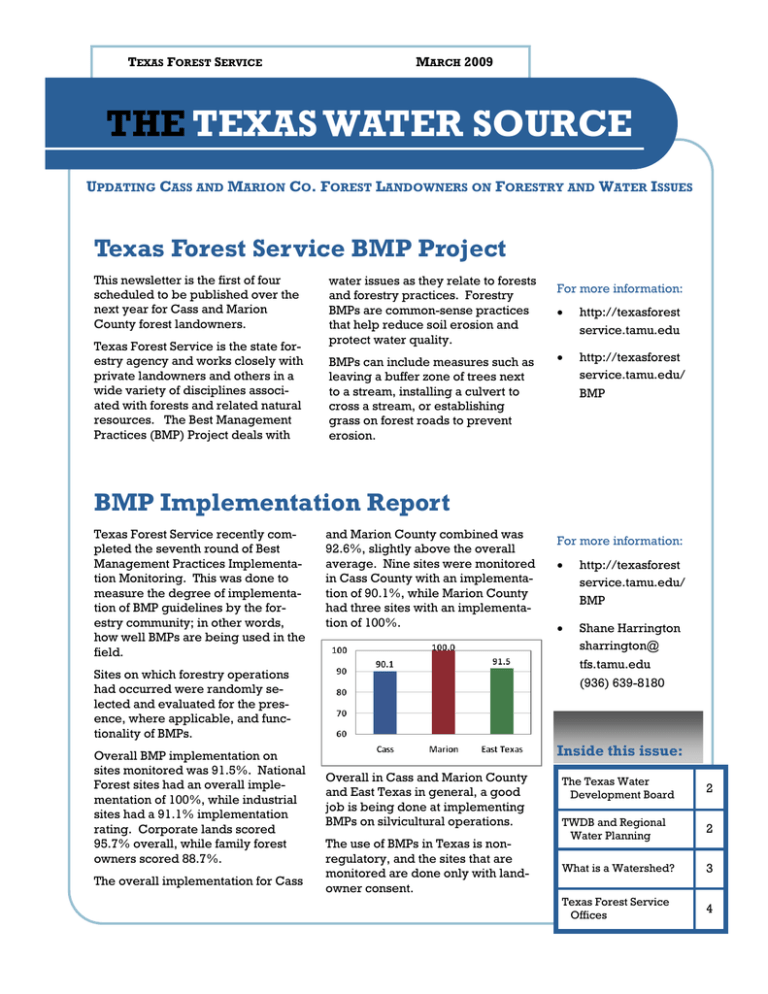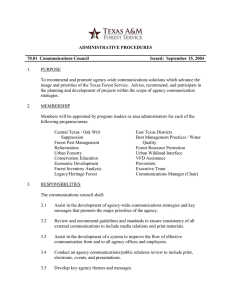THE TEXAS WATER SOURCE Texas Forest Service BMP Project U
advertisement

TEXAS FOREST SERVICE MARCH 2009 THE TEXAS WATER SOURCE UPDATING CASS AND MARION CO. FOREST LANDOWNERS ON FORESTRY AND WATER ISSUES Texas Forest Service BMP Project This newsletter is the first of four scheduled to be published over the next year for Cass and Marion County forest landowners. Texas Forest Service is the state forestry agency and works closely with private landowners and others in a wide variety of disciplines associated with forests and related natural resources. The Best Management Practices (BMP) Project deals with water issues as they relate to forests and forestry practices. Forestry BMPs are common-sense practices that help reduce soil erosion and protect water quality. BMPs can include measures such as leaving a buffer zone of trees next to a stream, installing a culvert to cross a stream, or establishing grass on forest roads to prevent erosion. For more information: • http://texasforest service.tamu.edu • http://texasforest service.tamu.edu/ BMP BMP Implementation Report Texas Forest Service recently completed the seventh round of Best Management Practices Implementation Monitoring. This was done to measure the degree of implementation of BMP guidelines by the forestry community; in other words, how well BMPs are being used in the field. and Marion County combined was 92.6%, slightly above the overall average. Nine sites were monitored in Cass County with an implementation of 90.1%, while Marion County had three sites with an implementation of 100%. Sites on which forestry operations had occurred were randomly selected and evaluated for the presence, where applicable, and functionality of BMPs. Overall BMP implementation on sites monitored was 91.5%. National Forest sites had an overall implementation of 100%, while industrial sites had a 91.1% implementation rating. Corporate lands scored 95.7% overall, while family forest owners scored 88.7%. The overall implementation for Cass For more information: • http://texasforest service.tamu.edu/ BMP • Shane Harrington sharrington@ tfs.tamu.edu (936) 639-8180 Inside this issue: Overall in Cass and Marion County and East Texas in general, a good job is being done at implementing BMPs on silvicultural operations. The use of BMPs in Texas is nonregulatory, and the sites that are monitored are done only with landowner consent. The Texas Water Development Board 2 TWDB and Regional Water Planning 2 What is a Watershed? 3 Texas Forest Service Offices 4 THE TEXAS WATER SOURCE Page 2 Agency Spotlight The Texas Water Development Board For more information: • • http:// www.twdb.state.tx .us/about/ aboutTWDBmain.a sp http:// www.twdb.state.tx .us/ABOUT/ history.asp The Texas Water Development Board’s (TWDB) mission is: To provide leadership, planning, financial assistance, information, and education for the conservation and responsible development of water for Texas. Its mission is a vital part of Texas’ overall vision and its mission and goals which relate to maintaining the viability of the state’s natural resources, health and economic development. To accomplish its goals of planning for the state’s water resources and for providing affordable water and wastewater services, the TWDB provides water planning, data collection and dissemination, financial assistance and technical assistance services to the citizens of Texas. Among other things, the TWDB provides loans to local governments for water supply projects; water quality projects including wastewater treatment, municipal solid waste management and nonpoint source pollution control; flood control projects; agricultural water conservation projects; and groundwater district creation expenses. It also supports regions in developing their regional water plans that will be incorporated into a statewide water plan for the orderly development, management and conservation of the state's water resources by studying Texas' surface and groundwater resources. Also, the TWDB administers the Texas Water Bank, which facilitates the transfer, sale or lease of water and water rights throughout the state, and administers the Texas Water Trust, where water rights are held for environmental flow maintenance purposes. TWDB and Regional Water Planning For more information: • • • http:// www.twdb.state.tx .us/wrpi/rwp/ rwp.htm http:// www.twdb.state.tx .us/wrpi/rwp/ d.htm http:// www.twdb.state.tx .us/wrpi/swp/ swp.htm In June 1997, Governor George W. Bush signed into law Senate Bill 1 (SB 1), enacted by the 75th Texas Legislature. This comprehensive water legislation was a result of increased awareness of the vulnerability of Texas to drought and to the limits of existing water supplies to meet increasing demands as population grows. With passage of SB 1, the Legislature put in place a "bottom up" water planning process designed to ensure that the water needs of all Texans are met. SB 1 allowed individuals representing 11 interest groups to serve as members of Regional Water Planning Groups (RWPG) to prepare regional water plans for their respective areas. These plans map out how to conserve water supplies, meet future water supply needs and respond to future droughts in the planning areas. SB 1 designated the TWDB as the lead state agency for coordinating the regional water planning process and developing a comprehensive state water plan. The water plans are updated every five years. So far, there has been a 2002 and a 2007 State Water Plan. To participate in regional water planning efforts, you may attend any of the RWPG meetings. Region D - Northeast Texas - will hold its next meeting on March 25, 2009, at 1:00 p.m. at the Mt. Pleasant Civic Center. Check the website on the left, as times and locations are subject to change. TEXAS FOREST SERVICE Page 3 What is a Watershed? may not have a well-defined channel. An intermittent stream carries water at least 30%, or about four months, of the year continuously, but not year-round. Intermittent streams have well-defined channels with scoured bottoms, a result of the flow. A perennial stream flows year-round, but may pool during drought conditions. Ephemeral stream Ephemeral Intermittent Intermittent stream Perennial Perennial stream Wa Watershed boundary A watershed is an area of land that drains rainfall into a stream or lake. It is generally named for the water body that is at the end, or downhill, portion of the area being considered. Watersheds vary considerably in size. For example, Little Cypress Creek drains an area of 718 square miles. However a small stream on your property may drain only a hundred acres. Keep in mind that your small stream flows into a larger stream that would be part of an even larger watershed. While forested watersheds provide the highest quality water, some forestry activities have the potential to lead to erosion. The use of Best Management Practices keeps the soil in place in the watershed, preventing siltation into streams. The figure above depicts a threedimensional watershed with its associated streams. An ephemeral stream, sometimes called a drain or swag, carries water only during and for a short time after a rain. An ephemeral stream may or These distinctions become important when deciding where Streamside Management Zones are recommended. As a general guideline, SMZs should be used along intermittent and perennial streams. These are the recommended minimum voluntary guidelines. Your common sense should guide your final determination. Caddo Lake watershed (illustrated below) includes these creeks: Big Cypress Bayou, Black Cypress Bayou, Deboldin Creek, Flat Creek, Frazier Creek, Harrison Bayou, James Bayou, Jims Bayou, Kelly Creek, Kitchens Creek and Little Cypress Bayou. This watershed drains 28,884 acres and has 158 lakes and ponds. The Caddo Lake watershed includes portions of the Texas counties of Cass, Harrison, Marion, and Morris, plus Caddo Parish in Louisiana. For more information: • http:// cfpub.epa.gov/ surf/huc.cfm? huc_code=111403 06 • http:// www.epa.gov/ owow/watershed/ Did you know… Losing a layer of soil the thickness of one dime across one acre (about the size of a football field including the end zones) amounts to losing 10,000 lbs. (5 tons) of soil per acre? TEXAS FOREST SERVICE THE TEXAS WATER SOURCE Updating Cass and Marion Co. Forest Landowners on Forestry and Water Issues Texas Forest Service Offices Distribution of The Texas Water Source is provided free of charge to forest landowners of Cass and Marion Counties. Funding has been provided through cooperation of the Environmental Protection Agency (EPA), the Texas State Soil and Water Conservation Board (TSSWCB) and Texas Forest Service (TFS). PLEASE ADVISE US IF YOU WISH FOR YOUR NAME TO BE REMOVED FROM OUR MAILING LIST. The Texas Forest Service is an Affirmative Action/Equal Opportunity Employer committed to Excellence Through Diversity. Texas Forest Service (TFS) has offices all over the state, including Central and West Texas. District offices serve forest landowners in all parts of East Texas. Urban foresters are housed in many of our larger cities such as Fort Worth, Houston and even El Paso! TFS fire personnel have offices all across the state. Some personnel in various offices deal with insects and diseases. In the Lubbock area, there is a nursery that grows tree and shrub seedlings used for windbreaks and wildlife. Learn more at our website at http:// texasforestservice.tamu.edu. Texas Forest Service offices serving Cass and Marion Co.: Russell Lykins District Forester P. O. Box 458 Linden, TX 75563 Chris Duncan BMP Forester 1203 W. Loop 281, Suite B102 Longview, TX 75604 907 Hwy. 59 S., Linden Vantage Plaza (903) 756-5571 (903) 297-3910 rlykins@tfs.tamu.edu cduncan@tfs.tamu.edu Best Management Practices Project P. O. Box 310 Lufkin, TX 75902-0310 Phone: 936-639-8180 Email: dwork@tfs.tamu.edu
